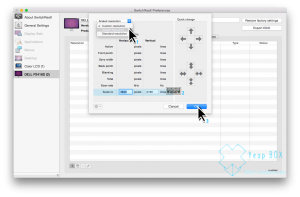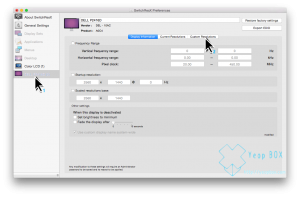



- Switchresx custom resolutis how to#
- Switchresx custom resolutis 1080p#
- Switchresx custom resolutis serial#
- Switchresx custom resolutis driver#
- Switchresx custom resolutis software#
Newer Intel GPUs are supported with the latest drivers.
Switchresx custom resolutis driver#

"(active)" means the display is connected and recognized by the graphics driver."*" means changes were made and an override was saved in the registry.Please read the sections below for more information. Repeat steps 2-3 for other displays if required.The "Copy" and "Paste" buttons at the top can be used to copy the resolutions, extension blocks, and range limits if included.
Switchresx custom resolutis serial#
It will not copy the name or serial number, but it will copy the inclusion of these items using the display's own information. If the display does not return after 15 seconds, press F8 for recovery mode.Run restart.exe to restart the graphics driver.Import follows the same logic unless "Import complete EDID" is selected. This will temporarily unload all the EDID overrides without deleting them. On some systems, the graphics driver might crash while restarting.Restart the driver again to reload any changes. If that happens, the driver might be disabled after rebooting. Simply run restart.exe again to enable the driver. Set the resolution in the Windows display settings.Windows 10: right-click on the desktop > Display settings > Advanced display settings > Display adapter properties > Monitor tab.Everything you see is based on the TV or monitor model. If your Mac is connected to an HDTV, this list may also include alternate refresh rates and display modes if supported by the hardware. Those using a 4K display can also click “Show low-resolution modes” to access the aforementioned low-rez options that will get upscaled via the device. When using the above steps, the row of five recommended resolutions gets replaced by a complete list of ALL supported resolutions. The Phillips TV above required this step because the top and bottom areas were not viewable. If you like a particular setting that fills the screen but cuts off the edges, slide the “Underscan:” slider until it properly fits your display area.Once you’ve found your desired resolution, click its entry in the list to switch your display.Press and hold the Option key on your keyboard, and then click the “Scaled” option again.
Switchresx custom resolutis how to#
Thankfully, these resolutions are still accessible, and here’s how to access them.
Switchresx custom resolutis software#
While adequate for the majority of users, these five resolution choices (default and scaled) are missing several “in-between” display options, as well as “low resolution” modes, such as a true 2560×1440 that must be upscaled by the monitor and may be necessary for testing or software compatibility purposes.
Switchresx custom resolutis 1080p#
On the Phillips HDTV, OS X suggests a “default” resolution of a Retina-scaled 1080p equivalent, and we have the choice to set other resolutions (“scaled”) including 1280 x 768, 720P, 1080i, and 1080p. An actual PC monitor usually displays a “Looks like # x #” resolution underneath the TV image in the options window. Click on “Scaled” to view the display choices.Īs referenced above, the external monitor connected to the Mac in the screenshots is a Phillips FTV HDTV, with a native resolution of 1080p. The exact resolutions will vary depending on the specifications of your external display. If you prefer a different screen size, OS X gives you four other options. By default, in recent versions of OS X, you’ll see a “default” recommended resolution for your external display.Select the window residing on the display you wish to modify. If you have more than one screen connected to your Mac, a new Display Preferences window will appear for each one. To change the resolution of your Mac’s display, head to System Preferences > Displays.


 0 kommentar(er)
0 kommentar(er)
